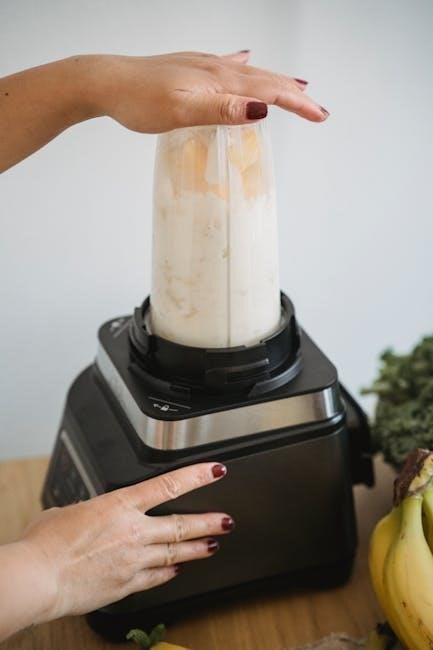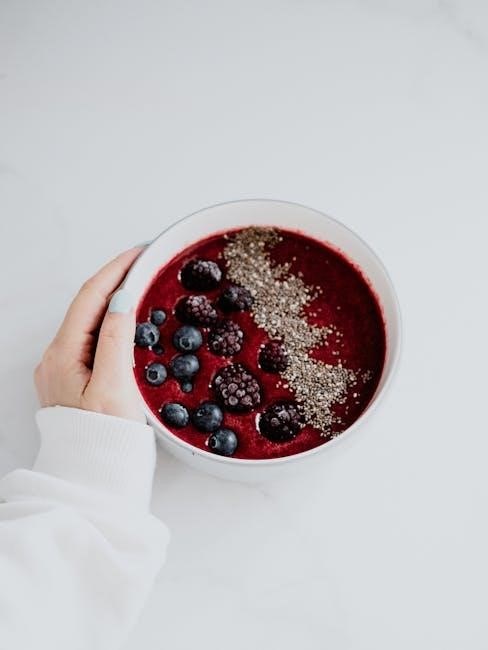fruit smoothie recipes pdf
Fruit smoothies are versatile, nutrient-packed beverages blending fresh fruits, vegetables, and enhancers. Perfect for health-conscious individuals, they offer customizable flavors and dietary benefits, making them a trendy choice.
1.1 What Are Fruit Smoothies?
Fruit smoothies are blended beverages made from fresh or frozen fruits, vegetables, and sometimes supplements. They often include ice, milk, or yogurt for texture. Smoothies are a healthy, customizable way to enjoy essential nutrients, offering a delicious and refreshing option for any time of day.
1.2 The Evolution of Smoothie Recipes
Smoothie recipes have evolved from simple fruit blends to nutrient-dense creations. Traditional recipes focused on basic fruits and ice, while modern versions incorporate greens, proteins, and supplements. The rise of health trends and social media has popularized innovative combinations, making smoothies a versatile and trendy choice for wellness enthusiasts and busy lifestyles alike.

Health Benefits of Fruit Smoothies
Fruit smoothies are rich in vitamins, minerals, and antioxidants, supporting immune function and energy. They promote digestive health and can aid in weight management and detoxification naturally.
2.1 Nutrient-Dense and Easy to Digest
Fruit smoothies blend nutrient-rich ingredients, offering essential vitamins, minerals, and antioxidants. Their smooth texture makes digestion easier, allowing quick absorption of nutrients. Perfect for those seeking a healthy, balanced option that supports overall well-being without overwhelming the digestive system. The combination of fruits, vegetables, and supplements ensures a boost of energy and vitality daily.
2.2 Boosting Daily Fruit and Vegetable Intake
Fruit smoothies are an excellent way to increase your daily consumption of fruits and vegetables. They allow you to combine a variety of ingredients, ensuring a balanced intake of essential nutrients. Smoothies make it easy to incorporate leafy greens, berries, and other vegetables into your diet, promoting better health and meeting nutritional goals effortlessly.
2.3 Supporting Weight Management and Energy
Fruit smoothies can aid in weight management by providing filling, low-calorie meals. They offer sustained energy due to natural sugars and fiber, reducing cravings. Blending fruits with leafy greens and healthy fats supports metabolism, helping maintain a balanced diet and boosting vitality throughout the day effectively.

Popular Fruit Smoothie Recipes
Discover delicious and refreshing blends like Tropical Mango, Strawberry Bliss, and Green Goddess. These recipes combine vibrant fruits, leafy greens, and creamy textures for a nutritious, flavorful experience.
3.1 Tropical Mango and Pineapple Smoothie
A vibrant blend of fresh mango, pineapple, and coconut milk, this smoothie offers a creamy, tropical escape. Rich in vitamins A and C, it combines sweet and tangy flavors. Add a splash of lime for zing or ice for thickness. Perfect for warm days, it’s a refreshing, healthy treat that’s easy to prepare and customize.
3.2 Berry Bliss: Strawberry and Blueberry Mix
A delicious combination of fresh strawberries and blueberries, this smoothie bursts with antioxidants and natural sweetness. Blend with Greek yogurt for creaminess or add honey for extra flavor. Packed with vitamins C and K, it’s a refreshing and healthy option perfect for breakfast or a midday snack, promoting energy and well-being.
3.3 Green Goddess: Spinach, Avocado, and Banana
This vibrant smoothie combines spinach, avocado, and banana for a creamy, nutrient-rich treat. Spinach provides iron and vitamins, while avocado adds healthy fats. Banana contributes natural sweetness. Optional ginger enhances digestion. Perfect for a healthy breakfast or snack, it’s packed with fiber and antioxidants, supporting energy and overall well-being in a delicious way.
Customizing Your Smoothie
Personalize your smoothie by choosing fruits, adding supplements, or enhancing flavors. Experiment with textures and dietary needs to create unique, nutrient-rich blends tailored to your preferences.
4.1 Choosing the Right Fruits
Selecting the right fruits is key to creating delicious smoothies. Opt for seasonal, fresh, or frozen varieties to ensure vibrant flavors and textures. Combine tropical fruits like mango and pineapple for sweetness, or berries for antioxidant-rich blends. Experiment with bananas, strawberries, or citrus fruits for creamy and refreshing results. Add ice if using fresh fruits for a thicker consistency.
4.2 Adding Supplements and Enhancers
Elevate your smoothies by incorporating supplements like protein powder, nut butter, or seeds for added nutrition. Honey, bee pollen, or stevia can sweeten without refined sugars. Greek yogurt or avocado enhances creaminess, while chia or flaxseeds boost fiber and omega-3s. These additions customize flavors and nutritional profiles, making smoothies more satisfying and tailored to your needs.
4.3 Balancing Flavors and Textures
Achieve harmony by blending sweet fruits like mango or berries with tart elements like citrus. Add creaminess with avocado or banana, and texture with ice or frozen fruit. Enhance depth with spices, herbs, or nut butter. Layering flavors and textures creates a smooth, refreshing, and visually appealing smoothie that delights the senses and satisfies cravings.

Nutritional Value of Smoothies
Smoothies are rich in vitamins, minerals, and antioxidants from fresh fruits and vegetables. They provide essential nutrients, fiber, and healthy fats, supporting overall well-being and energy levels naturally.
5.1 Vitamins, Minerals, and Antioxidants
Fruit smoothies are packed with vitamins A and C, potassium, and dietary fiber from ingredients like bananas, mangoes, and berries. Leafy greens add minerals such as iron and calcium, while antioxidants from berries, citrus, and spinach protect against oxidative stress, supporting immune function and overall health.
5.2 Fiber Content for Digestive Health
Fruit smoothies are rich in dietary fiber from whole fruits, vegetables, and leafy greens, aiding in digestion and preventing constipation. High-fiber ingredients like apples, berries, and spinach promote a healthy gut, improve nutrient absorption, and support regular bowel movements, enhancing overall digestive well-being and satiety.
5.3 Protein and Healthy Fats for Satiety
Fruit smoothies can incorporate protein sources like Greek yogurt, nut butter, or seeds, and healthy fats from avocados or coconut oil. These additions enhance satiety, keeping you fuller longer, and support energy levels while providing essential nutrients for overall well-being.
Smoothies as Meal Replacements
Smoothies can serve as nutritious meal replacements, perfect for breakfast, post-workout recovery, or busy days. They provide balanced nutrients, making them a convenient and healthy alternative to traditional meals.
6.1 Breakfast Smoothies for Weight Loss
Breakfast smoothies are a great way to kickstart your day while supporting weight loss. Packed with nutrient-dense ingredients like spinach, avocado, and banana, they provide sustained energy and satiety. Incorporating protein sources and healthy fats helps curb cravings. Plus, they’re easy to prepare and can be refrigerated or frozen for convenience, making them a perfect option for busy mornings. Customize with your favorite fruits or supplements for added flavor and nutrition.
6.2 Post-Workout Recovery Drinks
Post-workout recovery smoothies are designed to replenish energy and support muscle repair. Blending tropical fruits like mango and pineapple with spinach, avocado, and banana provides essential nutrients. Adding protein sources like Greek yogurt or nut butter enhances recovery. These drinks are rich in vitamins, antioxidants, and healthy fats, making them ideal for reducing muscle soreness and promoting overall wellness after exercise.
6.3 Healthy Alternatives for Busy Lifestyles
Fruit smoothies are perfect for busy individuals seeking quick, nutritious meals. They can be prepped in advance, frozen, and enjoyed on-the-go. Packed with fresh or frozen fruits, these drinks offer essential vitamins, fiber, and energy. Customizable with supplements, they provide a healthy, time-saving alternative to fast food, keeping you fueled and focused throughout the day.
Common Allergies and Intolerances
Fruit smoothies can accommodate common allergies like dairy, nuts, and gluten. Many recipes offer dairy-free, vegan, and nut-free options, ensuring everyone can enjoy smoothies safely and deliciously.
7.1 Dairy-Free Smoothie Options
Dairy-free smoothies are perfect for those with lactose intolerance or preferences. Use plant-based milks like almond, coconut, or oat milk. Add cashew or banana for creaminess. Enhance with protein powders or nut butter for flavor. These options maintain nutritional value while catering to dietary restrictions, ensuring everyone can enjoy delicious and healthy smoothies without compromise.
7.2 Vegan and Gluten-Free Recipes
Vegan and gluten-free smoothies are ideal for those with specific dietary needs. Use plant-based milks, gluten-free grains, and fresh fruits. Incorporate chia seeds, hemp hearts, or protein powders for added nutrition. Tropical fruit blends or spinach with almond milk are great options. These recipes ensure delicious, allergen-friendly drinks that cater to diverse preferences and restrictions without compromising flavor or nutritional value.
7.3 Nut-Free Alternatives for Safety
Nut-free smoothies ensure safety for those with allergies. Use seeds like sunflower or pumpkin as nut substitutes. Plant-based milks, such as oat or rice milk, are excellent bases. Fresh fruits, vegetables, and gluten-free grains enhance flavor and nutrition. These alternatives maintain creamy textures and delicious taste without compromising safety, making them ideal for schools or nut-free environments.
Presentation and Serving Tips
Presentation enhances appeal. Use tall glasses, garnish with fresh fruits or herbs, and add vibrant layers. Serve immediately for optimal texture and freshness, ensuring a delightful experience.
8.1 Garnishing with Fresh Fruits and Herbs
Garnishing with fresh fruits and herbs adds visual appeal and freshness. Try using berries, mint leaves, or citrus zest. Arrange creatively or layer vibrant colors to create an eye-catching presentation. This simple step elevates the smoothie experience, making it Instagram-worthy and more inviting to enjoy immediately.
8.2 Layering for Visual Appeal
Layering smoothies creates a stunning visual effect. Start with vibrant colors like berries or mango at the bottom, then add lighter shades. Top with fresh fruits, granola, or coconut flakes. This technique adds depth and makes photos stand out, perfect for social media or special occasions. It transforms a simple drink into a masterpiece.
Storing and Freezing Smoothies
Smoothies can be refrigerated for up to 2 days or frozen for later use. Store in airtight containers to preserve freshness and flavor. Thaw frozen smoothies overnight in the fridge for a quick breakfast option.
9.1 Refrigeration and Freezing Guidelines
Store smoothies in airtight containers to maintain freshness. Refrigerate for up to 2 days or freeze for up to 3 months. Use freezer-safe containers or bags to prevent freezer burn. Thaw frozen smoothies overnight in the fridge for a quick, nutritious breakfast or snack. Ensure containers are sealed tightly to preserve flavor and texture.
9.2 Thawing and Reusing Frozen Smoothies
Thaw frozen smoothies overnight in the refrigerator for a quick, ready-to-drink option. Once thawed, blend again briefly to restore texture and consistency. Add fresh fruits or ice if desired to refresh the flavor and texture. This method ensures convenience and maintains nutritional value for a healthy, hassle-free meal or snack.
PDF Resources for Smoothie Recipes
Discover free downloadable guides and comprehensive eBooks offering diverse smoothie recipes. These resources provide expert tips, nutritional insights, and creative ideas to enhance your smoothie-making experience.
10.1 Free Downloadable Guides
Access free downloadable guides packed with creative smoothie recipes, including mango, berry, and green options. These guides offer step-by-step instructions, nutritional tips, and customization ideas. Perfect for beginners, they provide inspiration and simplicity for crafting delicious, healthy smoothies at home. Popular guides include tropical blends, vegan recipes, and quick meal replacements.
10.2 Comprehensive Smoothie eBooks
Explore extensive smoothie eBooks offering detailed recipes, advanced techniques, and expert tips. These guides feature mango, spinach, and avocado blends, along with vegan and gluten-free options. Perfect for enthusiasts, they provide in-depth insights into creating nutrient-rich, flavorful smoothies. Popular titles include “The Ultimate Smoothie Guide” and “Green Smoothie Revolution,” ensuring a wide range of choices for every palate. Available for easy download, these eBooks inspire creativity and healthy living. Discover tropical, berry, and green goddess recipes tailored for breakfast, snacks, or meal replacements. Elevate your smoothie game with professional advice and diverse flavor combinations, all in one comprehensive resource.

Tips and Tricks for Making Smoothies
Prep ingredients in advance, use frozen fruit for thickness, and add ice for chill. Blend greens first, then liquids, and finish with solids for a creamy texture. Experiment with supplements like honey or protein powder for extra flavor and nutrition. Wash fresh fruits thoroughly before blending for safety.
11.1 Prepping Ingredients in Advance
Prepping ingredients in advance enhances smoothie-making efficiency. Wash, chop, and store fruits in airtight containers for up to 24 hours. Freeze fruits like berries or bananas for convenience. Portion and label ingredients for quick blending. Consider pre-mixing greens or supplements for consistency. This step saves time and ensures fresh, delicious smoothies every time.
11.2 Blending Techniques for Creamy Textures
For creamy textures, blend ripe bananas or avocados with Greek yogurt or nut butter. Add frozen fruit gradually, layering ingredients to ensure smooth blending. Start with soft items like spinach, then add fruits and liquids. Pulse briefly to avoid over-blending, creating a velvety consistency. This method enhances flavor and texture, making smoothies more satisfying.
Common Mistakes to Avoid
- Overloading smoothies with sugar from excessive fruit or sweeteners.
- Using too much ice, diluting flavors and nutrients.
12.1 Overloading with Sugar
Overloading smoothies with sugar from excessive fruit, sweeteners, or syrups can negate health benefits, leading to calorie-rich drinks. Balancing natural sugars with vegetables or protein ensures a nutritious, guilt-free treat without compromising flavor.
12.2 Using Too Much Ice
Excessive ice dilutes smoothies, reducing flavor and nutritional density. Use minimal ice for chill, relying on frozen fruits for creaminess. This preserves vibrant flavors and ensures a thicker, more satisfying texture in every blend.
Fruit smoothies are a delicious and healthy way to enjoy essential nutrients. With countless recipes, they cater to diverse tastes and dietary needs, promoting wellness effortlessly.
13.1 Final Thoughts on Fruit Smoothies
Fruit smoothies are a vibrant, healthy, and adaptable choice for any lifestyle. Packed with vitamins, minerals, and antioxidants, they offer endless customization. Whether for breakfast, snacks, or meals, smoothies promote wellness and satisfaction. Embrace creativity, experiment with flavors, and enjoy the convenience of a nutrient-rich drink tailored to your preferences and dietary goals.
